
www.shejapan.com> World Heritages > The Shrines and Temples of Nikko
Quiz:
| Description Quiz | T/F Quiz | Multiple Choice Quiz |
私は小学校の修学旅行以来訪れていない東照宮を中心とした日光の社寺を 選択し、それについて調べウェブテキストを作成することにしました。 英語に触れると同時に小学生の時に修学旅行時に得た知識よりも 深く詳しいものを当ウェブテキストでは触れているので、 私自身を含めみなさんが今後日光を旅行する際のよい予習になると思います。
2. Who is enshrined?

© ALPS MAPPING K.K.
Date of Inscription: 1999
Criteria: (i)(iv)(vi)
Brief description:
The shrines and temples of Nikko, together with their natural surroundings,
have for centuries been a sacred site known for its architectural
and decorative masterpieces.
They are closely associated with the history of the Tokugawa Shoguns.
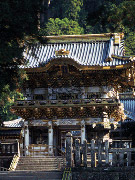 Toshogu is where Ieyasu Tokugawa (ruling from 1603 to 1605) is enshrined;
he was the first shogun of the Edo Shogunate, which flourished between the 17th and 19th
centuries.
As many as 127,000 craftsmen were involved in constructing the shrine,
using the highest level of technology available at the time.
The two-story "Youmei-mon Gate"*2, decorated with brilliant colors and over 500 sculptures,
is particularly famous. It is also called "Higurashi-mon (sunset gate)",
because people spend all day long gazing at its beauty.
Toshogu is where Ieyasu Tokugawa (ruling from 1603 to 1605) is enshrined;
he was the first shogun of the Edo Shogunate, which flourished between the 17th and 19th
centuries.
As many as 127,000 craftsmen were involved in constructing the shrine,
using the highest level of technology available at the time.
The two-story "Youmei-mon Gate"*2, decorated with brilliant colors and over 500 sculptures,
is particularly famous. It is also called "Higurashi-mon (sunset gate)",
because people spend all day long gazing at its beauty.
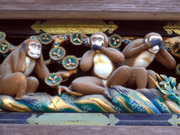 If you pass under Youmei-mon, turn right and enter the avenue leading to the shrine
at the back, you will see the "Sleeping Cat" overhead,
a national treasure created by legendary master Hidari Jingoro.
The story behind the carving is that the cat was to ward off mice,
because it is situated near the gate leading to the grave of Ieyasu.
In the "Shinkyusha (sacred stable)"*3 for the horses serving God,
there is a series of 8 carved boards on which the life of a monkey is illustrated,
from birth to pregnancy, caricaturing human life.
One of the sculptures, the "Three Monkeys", is famous throughout the world for
the "see no evil, hear no evil and speak no evil" poses.
The carved monkeys covering their eyes, ears and mouth,
respectively, were inspired by the Buddhist teaching that if we do not hear,
see or speak evil, we ourselves shall be spared from evil,
and the theme was chosen here in the belief that
the monkeys would protect the horses from disease.
If you pass under Youmei-mon, turn right and enter the avenue leading to the shrine
at the back, you will see the "Sleeping Cat" overhead,
a national treasure created by legendary master Hidari Jingoro.
The story behind the carving is that the cat was to ward off mice,
because it is situated near the gate leading to the grave of Ieyasu.
In the "Shinkyusha (sacred stable)"*3 for the horses serving God,
there is a series of 8 carved boards on which the life of a monkey is illustrated,
from birth to pregnancy, caricaturing human life.
One of the sculptures, the "Three Monkeys", is famous throughout the world for
the "see no evil, hear no evil and speak no evil" poses.
The carved monkeys covering their eyes, ears and mouth,
respectively, were inspired by the Buddhist teaching that if we do not hear,
see or speak evil, we ourselves shall be spared from evil,
and the theme was chosen here in the belief that
the monkeys would protect the horses from disease.
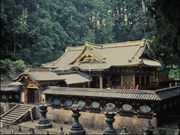 In addition to these carvings, there is also one of an elephant,
purely from imagination, in a temple called "Kamijinko"*4.
The Toshogu Three Sculptures<Tips> are small, but incredibly beautiful,
and there is always a crowd of people in front of them.
In addition to these carvings, there is also one of an elephant,
purely from imagination, in a temple called "Kamijinko"*4.
The Toshogu Three Sculptures<Tips> are small, but incredibly beautiful,
and there is always a crowd of people in front of them.
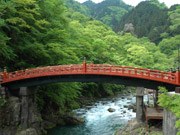 The "Shinkyo Bridge"*5 acts as a gateway to the shrines and temples of Nikko
and is one of the three most unusual bridges in Japan. According to legend,
when a certain saint tried to cross the rapids of the Daiyagawa River"*6,
two snakes formed a bridge for him to walk across.
An 8-year repair work program was completed in March 2005
and the bridge is now open to the public again.
The arch-shaped bridge covered in vermillion lacquer supported
by stone piers is most attractive in the fall
when the mountain trees are a dazzling red and yellow.
The "Shinkyo Bridge"*5 acts as a gateway to the shrines and temples of Nikko
and is one of the three most unusual bridges in Japan. According to legend,
when a certain saint tried to cross the rapids of the Daiyagawa River"*6,
two snakes formed a bridge for him to walk across.
An 8-year repair work program was completed in March 2005
and the bridge is now open to the public again.
The arch-shaped bridge covered in vermillion lacquer supported
by stone piers is most attractive in the fall
when the mountain trees are a dazzling red and yellow.
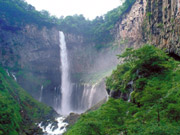 Some must-see sights in Futarasan-jinja include the vermillion lacquered shrine pavilion
and the "Obake toro (haunted garden lantern)"*7 next to it.
The lantern is rumored to change into a spooky shape when lit at night,
and it still bears the scars from numerous sword strikes made
by startled samurai warriors.
Rinnoji is one of the temples representing the Tendai School of Buddhism
along with Hieizan Enryakuji (Otsu City, Shiga prefecture)
and Kaneiji (Taito-ku, Tokyo).
A gold leaf wooden Buddha, 8.5 meters high, is enshrined within the main hall.
Some must-see sights in Futarasan-jinja include the vermillion lacquered shrine pavilion
and the "Obake toro (haunted garden lantern)"*7 next to it.
The lantern is rumored to change into a spooky shape when lit at night,
and it still bears the scars from numerous sword strikes made
by startled samurai warriors.
Rinnoji is one of the temples representing the Tendai School of Buddhism
along with Hieizan Enryakuji (Otsu City, Shiga prefecture)
and Kaneiji (Taito-ku, Tokyo).
A gold leaf wooden Buddha, 8.5 meters high, is enshrined within the main hall.
| 眠り猫 |
| 眠り猫が何の象徴であるかは、奥社をネズミから守るという本文の説のほか、3つの説があるとされている。 |
■安定と平和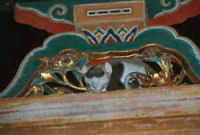
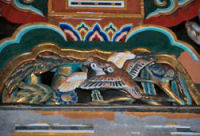 眠り猫(左写真)の真裏に雀の彫刻(写真右)がある。 猫が起きていれば雀は食われてしまうが、東照宮では猫も居眠りして雀と共存共栄していて、 つまり戦乱が治まった平和な時代がやってきたことを表している。 |
|
■牡丹花下眠猫児 禅問答である「牡丹花下眠猫児(ボタンカカスイビョウジ)」を表現している。 |
|
■日の光 牡丹と眠る猫で「日の光」を表現している。 |
| 「三猿」の物語 |
| 神厩舎の長押(ナゲシ)の上には物語性のある8面にわたる猿の彫刻が施されている。 |
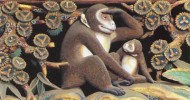
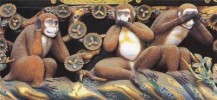 ①手をかざした母猿が子猿の将来を見ている。子猿は信頼して母猿の顔をのぞきこんでいる。 ②「三猿」:子供のとき (純粋な時)には、悪いことを「見ざる・言わざる・聞かざる」が良い。 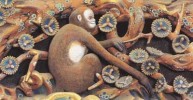
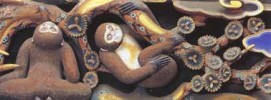 ③一人立ち直前の猿。まだ、座っている。 ④大きな志を抱いて天を仰いでいる。右側の青い雲は「青雲の志」を表す。 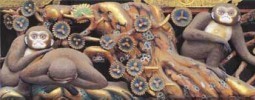
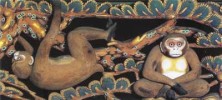 ⑤人生にまっすぐ立ち向かうが、崖っ淵に立つときも。迷い悩む仲間を励ます友がいる。 ⑥恋に悩み、もの思いにふける男女の猿。 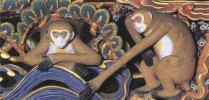
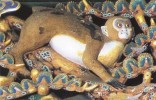 ⑦結婚した2匹の猿で、「人生の荒波」が彫られ、力を合わせて乗り越えようとしている。 ⑧妊娠した猿。 〜そして子供が生まれまた左端(①)に戻り同様の人生を過ごす〜 |
| 「想像の象」 |
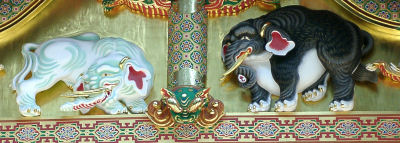 下絵を描いたとされる狩野探幽(かのうたんゆう)が本物の象を見たことが無く想像で作られたため「想像の象」と呼ばれている。 |
日光という身近な世界遺産について、三猿の意味や複数枚からなる一連のものであることなど 今回初めて知ったことが多く、次回訪れるときはまた違った楽しさを感じられるようになったと思います。 また英語のサイトは日本人が作ったものが多かったり、 日光を旅行した際の写真とそのコメントが主体で日光について深く触れられていない紀行文にとどまるものが多かったりで 適切な英文を探してくるのに苦労しました。
1) 東照宮、二荒山神社、輪王寺
enshrine:祭る
flourish:
栄える
story:階
2) 陽明門
sculpture:
彫刻
ward off:
避ける、防ぐ
3) 神厩舎
pregnancy:
妊娠
caricature:
風刺する
throughout:
〜の至る所に
4) 上神庫
5) 神橋
6) 大谷川
lacquer:漆
pier:橋脚
pavilion:別棟
7) 化燈籠(ばけどうろう)
rumored:
噂されている
spooky:
薄気味悪い
gold leaf:
金箔
EXTRACTS
'Reading Passage' from Japan National Tourist Organization - World Heritage Sites in Japan
www.shejapan.com> World Heritages > The Shrines and Temples of Nikko
© 2008 SHEJapan.com